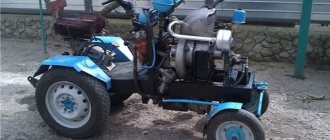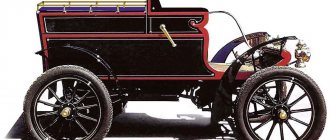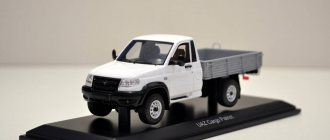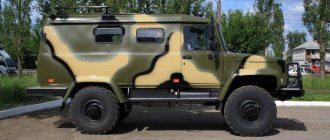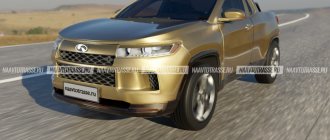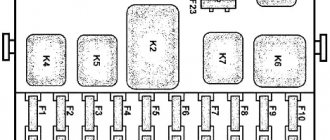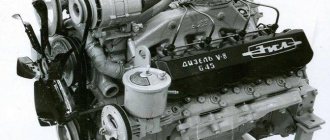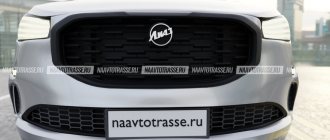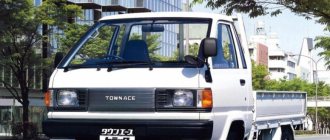Return of "Cheburashka"
Daniil Minaev, Roman Bodnar Photos by the authors, Vyacheslav Trunov, and also from the archives of AMO ZIL
There's no harm in dreaming! But not everyone succeeds in realizing their dream with their own hands. When I first saw this car, I realized that I was not alone in my creative ideas for creating unusual “customs”. And besides, this is such a dear and familiar “Cheburashka” from the “Zilov” years. This type of pun on automaker jargon may be off-putting to the reader. Now I will explain everything.
At the Autoexotica 2012 festival there was a nice orange pickup truck in the American style. Not an American, but a “130th Zilok”, the cabin design of which, undoubtedly, was taken from overseas automakers of the mid-twentieth century. It looked elegant and harmonious and reminded me of the existence of another interesting car. When, after graduating from MADI, I worked at UKER AMO ZIL and was involved in testing passenger limousines, the carrier of the units and measuring equipment was a rather rickety and therefore terribly beloved little car nicknamed “Cheburashka”. For the uninitiated, I’ll explain that ZIL limousines are a frame structure, and therefore nothing prevents you from installing not only a passenger body on this frame. So the idea for this mini-truck came about. On the Moscow streets of the 1980s - 1990s, this low ZIL with a cab from the “131st” shocked absolutely everyone. Especially when starting from a traffic light - the 315 horsepower of the Zilov passenger car engine and the three-speed automatic transmission confused seasoned drivers. But the AMO ZIL passenger program and everything connected with it were consigned to oblivion. And suddenly... the appearance of “Cheburashka” again.
On a large, airy, tangerine-colored ZIL
It is the words of this simple song that come to mind when just looking at this solar miracle. And if it weren’t for the painfully familiar front end of the native ZIL, you might think that the photo shows some old American rarity that has been fully upgraded in one of the popular shows in the USA.
Fashionable wheels with a much smaller radius and an unusual print that literally runs a red line across the entire body of the modernized car also contribute to the overall picture. As for the “naturalness” of the car itself, there is certainly no doubt about it. Although…
Body part
A photo of the ZIL-130 tuning after converting it into a pickup truck is presented below. At the final stage, the body and sheet metal fenders will need to be treated with putty and painted to match the tone of the entire car.
With a creative approach, you will get a unique specimen both in terms of technical characteristics and from a design point of view. The final touch will be equipping the pickup truck with original lighting elements, mirrors, and moldings.
ZIL-130: tuning, photo after modernizing the car on News4Auto.ru.
Our life consists of everyday little things that in one way or another affect our well-being, mood and productivity. I didn’t get enough sleep - my head hurts; I drank coffee to improve the situation and cheer myself up - I became irritable. I really want to foresee everything, but I just can’t. Moreover, everyone around, as usual, gives advice: gluten in bread - don’t go near it, it will kill you; A chocolate bar in your pocket is a direct path to tooth loss. We collect the most popular questions about health, nutrition, diseases and give answers to them that will allow you to better understand what is good for your health.
Barbie mobile
Looking at the bright colors of this Zilopikup, it is impossible to believe that it could be driven by a man, or rather some glamorous blonde. However, even such a character will look quite comical behind the wheel of this car, because whatever one may say, we are talking about a ZIL, albeit in a rich pink color.
Of course, it is possible that such tuning was not made for a spectacular ride, but for thematic photo shoots in the Cuban style in the Soviet style (there will definitely be those who want it), however, how this idea will fit into Russian city landscapes is unclear.
ZIL - not only ZILovo
The entire project can be divided into 3 stages.
1. Installation of the ZIL-130 cab and combining it with Ford units.
2. Body manufacturing and design development (current stage).
3. Improving the dynamic qualities of the car, up to outstanding.
So, a little about the donor power unit of our pickup truck. Ford E-250 Econoline is a classic American “Full Size Van”, almost 6 m long and a little over 2 m wide. The curb weight of the vehicle is 2300 kg. Its immodest load-carrying capacity predetermined a powerful spar frame, a durable automatic transmission, a rear axle, and a 4.2-liter engine. The Ford 4.2 engine was installed in Mustangs, F-series pickups and E-series buses. Has great tuning potential. Now its power is 200 hp. (Euro 3, 4 catalysts), but due to the modified exhaust and tuning, the power for the first time will be about 250 forces, and the torque will be about 400 N∙m. In the future, the engine will undergo revision and will be boosted.
Ghostbusters
The car, like the surroundings, is impressive, clearly reminiscent of the good old animated series about Ghostbusters. In any case, converted to an American pickup truck of the 50s, ZIL looks a lot like Lizun, having received almost identical colors.
If we discard any associations, then we can see that the almost zero ground clearance, which can be observed in this converted pickup truck, is considered a special chic among the craftsmen. It is also worth noting that achieving such an effect is not at all difficult - properly selected small-radius wheels will certainly cope with the task.
Stages of car construction
As an employee of a car building studio, I could not help but come up with something similar, and the “shoemaker without boots” principle is not for me. Initially, the idea arose to build a pickup truck based on the Volga in the style of the Chevrolet El Camino and Ford Ranchero pickups. The car was almost ready in terms of bodywork, the only thing left was the V8 engine, which I ordered, but never received due to some problems with the supplier. I began to think about other options, including purchasing a donor car. But then a good friend of mine called and offered an option with an American full-size van (Ford E-250 Econoline). I took it without hesitation. At first I tried to attach the body of a Volga to the frame of an American bus. As you yourself understand, it turned out funny, but nothing more. I was upset. I thought for a long time, weighing my options. But one morning, walking past a hangar with various equipment, I accidentally saw an old ZIL fuel truck and realized: this is it! I always liked the ZIL-130. Of course, because the design of its cabin is a combination of the best examples of the American automobile industry of the 50s of the twentieth century. There is panoramic glass, wide wings, a rounded stylish design, and it fits in size. So I thought, why can they do it in America, but we haven’t made a single efficient pickup truck?!
And then off we go. At the geological exploration base I bought a cabin from a polar drilling station. The car had been working at the pole since 1976, had double glazing with an alcohol layer, bars on the windows, fur insulation of the interior and... a rotten bottom.
This may seem like nonsense to some readers, but the northern version of such vehicles as KrAZ, ZIL, and Ural involves both glass with filler and covering using glass wool or faux fur, so I’m telling it like it is! The radiator grille was installed from the first ZIL-130 samples. I searched for a very long time - I found either rotten or broken ones. As a result, purely by chance I found a fairly dusty grille in one large auto store. No one remembers how she got there.
bitter chocolate
Another gorgeous remodel that definitely deserves attention. Of course, even from the photo you can see that a considerable amount of money was spent on tuning this “chocolate”.
Spectacular blown fender fenders with a platform mounted on them without the usual sides, stylized optics and radiator grille, titanium wheels on concave spokes - it’s hard to even imagine what kind of cargo can be transported on such a pickup truck.
Perhaps it is being used as a hearse for the mafia? Or do they arrange unusual dates right on his loading dock?
Most likely, these questions will remain rhetorical, providing endless possibilities for the imagination of random eyewitnesses and network users whose eyes catch this photo.
Frame and suspension
When tuning a ZIL-130 with your own hands in the direction in question, the “Ford” frame is shortened by cutting out the necessary parts and then welding the side members again. Reinforcing elements are laid along the seams. The frame is cleaned of rust, treated with a primer and painted orange.
In accordance with the length of the frame, the cardan and fuel tank are shortened. The first part is cut on turning equipment, after which the fitted parts are welded into a solid block. After the modification, the tank loses about 50 liters in volume and in the final version holds about 90 liters.
The springs in the suspension are cut and the spring earrings are modified, which ensures that the car is lowered by about 50 cm (across the cabin). The wheels are equipped with alloy wheels with a classic pattern and size 305/55R20.
NEGRA
This ZIL contrasts strongly with the previous ones, clearly losing in its much more modest tuning. And if you look at the front of the car, thoughts come to mind about a truck that has lost its sides, albeit on a slightly lowered suspension.
Nevertheless, the craftsmen tried their best, and even selected a non-standard number, however, according to what principle is unknown (not according to national standards, because by modern standards this is at least incorrect).
Notable Details
What catches your eye in this still unfinished car is the interior heater from a Ford bus installed in the body behind the cab. Installation behind the cab is dictated by the location of the engine and the space available in the cab. It was not possible to place such a massive heater and even an air conditioner in the cabin and under the hood.
And one more feature. One of the main stages of the project is shortening the frame. The main reason is that a car is built for oneself, for pleasure. But with a long wheelbase, the negative still pops up, since this is a rather long and clumsy car; in order to leave the garage, you need to make a lot of rearrangements. So, the body, cardan, tank, lines have been removed. And after changing the proportions, the car acquired a new look. Next I will give a comparison of the dimensions, as well as the engines of the ZIL and the prototype - Ford F100 1956.
Ford f 100 1956
- 3500 cm3 in-line, six-cylinder 101 hp.
- 3700 cm3 in-line, six-cylinder 137 hp.
- 3900 cm3 V8 101 hp
- 3900 cm3 V8 130 hp
And finally, the most powerful engine, because of which the F100 was known as the “American racing truck of the 1950s”
- * 4500 cm3 V8 173 hp
Zil 130 R/T
- * 4200 cm3 V6 201 hp
To install it on the Ford frame of the Zilov cab, the bottom and power structure of the Soviet truck had to be completely redesigned. After that, from below the cabin began to look like either a piece of granite or a garbage container.
The pedal assembly also required serious reworking. It’s uncomfortable to sit in a ZIL, let alone drive, especially with my height (1.89 m). The pedal assembly is moved forward by 15 cm, it has become much easier! If you move back, you can cross your legs, but if you straighten your legs, then, for example, I can’t reach the pedals.
Regarding the pendants. It is not yet possible to make the car lower. The frame is indeed very bulky, the cabin is fixed at the minimum possible height. The front springs have been shortened by one and a half turns. First they cut off more, and... the car lay down on the bump stops. I had to redo it. Such is the kinematics of the suspension that with this option the minimum permissible travel is maintained. The rear part is a little easier, but I had to work hard. Firstly, it was very difficult to unscrew the earring bolts that had become soured in the bushings. Secondly, it was simply luck that a certain grade of steel was available to provide the necessary strength without increasing the thickness. And one more thing: due to the long wheelbase and the design features of the automatic transmission mounting, the resulting ground clearance is minimal; with less, I simply won’t leave the garage, I’ll hang on my belly halfway to victory.
As a result, the height of the ZIL is 1.90 m, while that of the standard ZIL is 2.40. For the wheels, they decided to leave these rims on the front, but slightly widen the track using spacers; the tires will be 245/75 R16, but at the rear they plan to “weld them” and tires in the region of 295-315/70 R16. I think it will look good...
Fireman pickup
For firefighters in Soviet times, they produced their own modification of the ZIL with an enlarged cabin with two rows of seats. Another thing is that initially there were sides at the rear of this special equipment, but for some reason the mechanics decided to get rid of them.
The chassis of the company car also underwent semi-tuning, as a result of which it retained the old suspension, but lost its previous wheels, being placed on a much smaller radius, which is visible to the naked eye from the distance between the tires and fender liners. Well, maybe the firefighters needed bigger wheels for other purposes, like the van that disappeared in an unknown direction?
Tuning always gives controversial results, being to the taste of some and causing sharp condemnation from others. Be that as it may, the main thing is that the owners like it, and the masters will make every effort to please them, because their reputation directly depends on this.
"Cheburashka" from the experimental workshop of AMO ZIL
In the 1950s, in the laboratory of the Department of Design and Experimental Work (UKER) of the capital's ZIL automobile plant, which was involved, among other things, in testing passenger cars, a high-speed light-duty truck was built to transport gasoline during run tests of new models of government limousines. Literally spread out on the ground, the “four-eyed” truck with a long “nose”, low wide wings and tiny wheels looked funny, although somewhat defiant. For its colorful appearance, the car was called “Cheburashka”. This nickname stuck, and therefore all subsequent varieties began to be called that way.
The second generation of Cheburashkas made their presence known in 1983–1984, when the plant built a couple of cars for its own needs, but on the chassis of a high-class ZIL-4104 passenger car. Now, under the hoods of the twins, which received state numbers 95-50 MNP and 95-51 MNP, a 315 hp engine, coupled with a hydromechanical three-speed automatic transmission, took its place. Vehicles of this series received standard cabins from the ZIL-131 three-axle cargo truck, as well as wooden side bodies unified with the ZIL-130, which were equipped with awnings that covered three-quarters of the length of each platform. In road tests, small-tonnage trucks were also used to carry out economic intra-shop purposes.
Thanks to its bright appearance, “Cheburashkas”, like a magnet, attracted the gaze of idle passers-by, private drivers, and professional motor transport workers. But first of all, a truck with disproportionately small wheels spread out on the ground raised questions among traffic police representatives, especially in Soviet times. The car was often stopped not so much to check the driver’s documents, but rather to inquire about the technical characteristics of a never-before-seen car. Everyone was most delighted by the engine compartment, which comfortably accommodated a V-shaped petrol “eight”.
Loading platform
It just so happened historically that in the homeland of pickup trucks, the cargo part of the vehicle was used maximum for transporting goods from a store or firewood for a picnic. You can do the same on the created model. If necessary, it is possible to load and transport fairly heavy but compact objects weighing up to several tons. To manufacture this element, you will need another pair of front wings, sheet metal and a reinforcing profile attached to the base. All parts are selected in such a way that they can withstand the load to which the chassis is oriented.
If we summarize all the indicated manipulations of the second version of tuning, we can note that this is a rather abstract project. Bringing it to life will require a lot of finances, time and effort. At the same time, no one will give you any guarantees that you will be able to move legally on the roads. In addition, the participation of several multidisciplinary specialists will be required to help identify and think through all the technical and design nuances.
Interesting Facts
At the Autoexotica automobile festival in 2012, you could see a beautiful orange ZIL pickup truck (photo above). The design slightly copied the masterpieces of foreign designers of the middle of the last century. Overall the car looked quite decent and harmonious. It was difficult to recognize it as a “Cheburashka”, which was used at one time for transporting technical and measuring equipment.
Brief information. Various versions of bodies could be mounted on the frame part of ZIL limousines. That's when the idea of creating a small truck arose. At that time, when he appeared on the street, he shocked absolutely everyone. Sadly, this project was quickly abandoned, so only a few copies were produced. Nevertheless, there were those who were able to restore the forgotten car.
Second option
Another version of tuning the ZIL pickup truck also has a right to exist. True, it is presented in theory so far, so there is no step-by-step description of the work, but there is a clear idea of the general principle of the manipulations.
To start:
- Frame base – the original model remains with some shortening.
- Bridges are unchanged, with the possibility of adding components from American “colleagues”. This will ensure the reliability of the unit and the installation of disc brakes.
- Suspension - the leaf spring assembly remains. It may look a little brutal, but it is “cheap and cheerful.” If you want to make drastic changes, the optimal solution would be a pneumatic design, parts for which can be found on the modern market without any problems.
- Twin wheels are required on the rear axle. Otherwise, the car will look awkward.
- The power unit with transmission is better taken from foreign analogues. The choice here is quite wide. Both the original V-8 and Cummins, Caterpillars and the like will do.
Cabin and interior
Remodeling the cabin itself to change the proportions doesn’t make much sense. A ZIL-based pickup should still remain a truck, albeit with a slightly different classification. Take, for example, the same Americans who are actively creating unique pickup trucks based on medium-duty trucks. If desired, you can install a double cabin, then some alterations will be required. Even the firefighter cabins of the Cheburashkas were at one time subjected to adjustment, extension and welding.
Interior equipment is another area for introducing your own imagination and design solutions. First of all, it is necessary to provide decent noise and thermal insulation, modify the seats, steering wheel, dashboard, and lighting. Further, the choice of modernization elements is almost unlimited. Alternatively, you can leave the minimum Spartan equipment.
